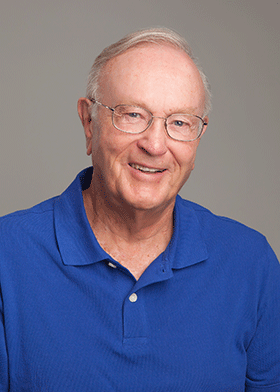Geology Professor Kent Condie Wins GSA's Top Award
July 18, 2018
SOCORRO, N.M. – New Mexico Tech professor emeritus Dr. Kent Condie won the highest honor from the Geologic Society of America this year, the Penrose Medal.
“Basically, it’s the highest award given by the GSA and only given once per year,” said his colleague at NMT, Dr. Fred Phillips. “It’s a lifetime achievement award. You have to have a truly remarkable contribution to geoscience to even be considered.”
The Penrose Medal was established in 1927 by R.A.F. Penrose, Jr., to be awarded in recognition of “eminent research in pure geology, for outstanding original contributions or achievements that mark a major advance in the science of geology.” The award is made only at the discretion of the Council, which interprets pure geology to apply to all scientific disciplines represented by the Society.
 A professor at New Mexico Tech since 1970, Condie has contributed several books on
plate tectonics. He first published Plate Tectonics and Crustal Evolution in 1976.
Now in its fourth printing, the text is widely used in academia. His most recent book,
Earth as an Evolving Planetary System, is an updated version of Plate Tectonics published
in 2006.
A professor at New Mexico Tech since 1970, Condie has contributed several books on
plate tectonics. He first published Plate Tectonics and Crustal Evolution in 1976.
Now in its fourth printing, the text is widely used in academia. His most recent book,
Earth as an Evolving Planetary System, is an updated version of Plate Tectonics published
in 2006.
“Plate tectonic theory was being born when I worked on my Ph.D. in the early 1960s at Scripps Institution of Oceanography (UC San Diego),” he said. “I’ve seen significant evolution of the theory over the years.”
Kent Condie, Penrose Medal winner
Condie is a prolific researcher and publisher. Phillips said, “Without question, Kent is the most cited scientist of original research to be on the New Mexico Tech faculty in its history.”
Condie’s forte is using geochemistry of various earth materials through the geologic history to infer very important things about the planet’s history, particularly the first two to three billion years of Earth’s history.
Phillips said, “He’s been able to take enormously wide range of data from composition of rocks to sophisticated isotopic data and synthesize it to illuminate the evolution of the Earth in a way that almost no one else has done.”
Dr. Robert Stern, professor at the University of Texas-Dallas, was one of six people to nominate Condie for the award.
He said, “The Penrose Medal is a hard one to get; and he deserves it. I admire his work and his way of interacting with people. His contributions are tremendous. He’s had a helluva career and this is the time to recognize him.”
Stern said he first became familiar with Condie when he started using Condie’s text book for a class. Over the years, he has invited Condie to give talks at UT-Dallas and they organized a Penrose Conference together.
“The general field of tectonics is where he’s really contributed,” Stern said. “He’s a prolific writer about the early time in Earth history. The farther back you go, the harder it is to reconstruct. There’s great interest in that because that’s when life started, the planet developed its habitability, and plate tectonics started, which is the dominant model for Earth geology today.”
“But at heart, he’s a field geologist – looking at rocks in the field and bringing them back to the lab. Kent was always interested in observation.”
For many years, Condie lead a summer field excursion on rivers around the Southwest. The Earth and Environmental Science Department kept a flotilla of rafts and Condie would lead the trip. Phillips said Condie developed a reputation among students for leading long, arduous field excursions.
“He’d get 25 students for a field trip in the Quebradas and he’d take off and it was up to the students to keep up,” Phillips said. “He’d finish up with only six students and the remaining would trail in over the next two or three hours – the Condie Death Marches.”
Condie doesn’t get into the field much anymore, but he is still teaching and doing research. He taught his class “Earth as an Evolving Planetary System” in the spring; and he has three ongoing research projects.
In one project, he is examining cycles in Earth’s mantle with periods from 90 to 300 million years ago. He is using uranium-lead dating of zircons to uncover what happened at the core-mantle interface during times of major global geologic events.
Another project has Condie looking at changes in Earth’s crust and whether plate tectonics are required to form continents. He is comparing data from Earth with data from Venus and Mars, neither of which have plate tectonics.
In a third project, he is collaborating with a colleague at the University of New Mexico to compare asteroids from the moon, Mars, and Vesta. “The Earth history that is preserved starts about 4 billion years ago, so we don’t have the first 500 million years or so of Earth’s history. So we have to go to other planets that record that history. The moon, Venus, and Mars might give us data on that.
Condie enjoys staying current on a variety of research topics. He follows 35 to 40 journals every two weeks.
“Science is exciting and once you’re into it, most people don’t give it up,” he said. “It’s challenging work, no matter what your age. It’s hard to put it down, at least it is for me.”
– NMT –